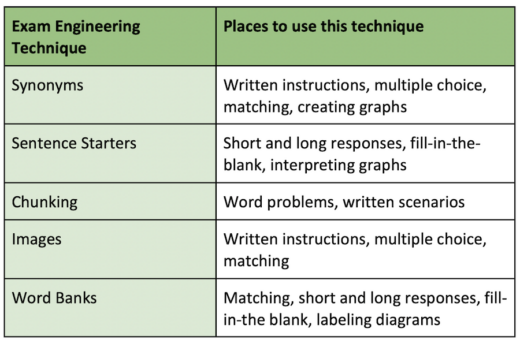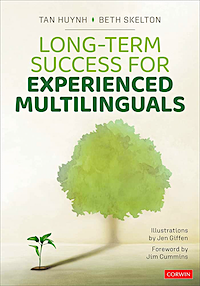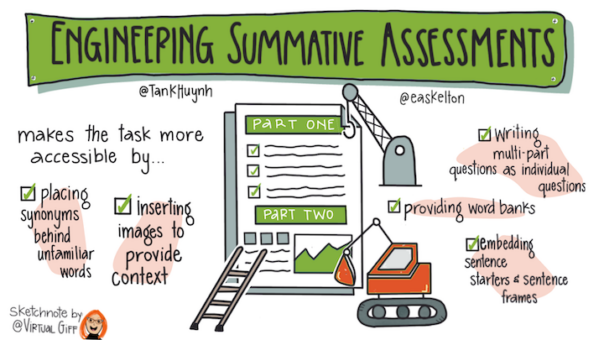Building Justice into Exams for Multilinguals
By Tan Huynh and Beth Skelton
Content-based exams are supposed to gauge students’ understanding of discipline-specific skills and concepts. But for many multilingual students, exams are a reading and writing test in disguise.
Take for example this matching vocabulary question on a Grade 7 science test where students have to choose the matching word for this definition: an organism that produces its own food by absorbing solar energy. In the unit, students learned what a producer is; however, when reading this sentence, the unfamiliar words (bolded) make this matching task a reading comprehension one.
This task would be more equitable if students had this version of the test: an organism (a living thing) that produces its own food by absorbing (taking in) solar energy (sunlight). Adding the synonyms and accessible definitions behind the unfamiliar words prevents this test from becoming a reading test.
This is what we mean by justice for experienced multilinguals, the largest group of multilingual learners between grades 4-12. Justice means scaffolding for students’ success without lowering the expectations. Students are held to the same expectations but receive appropriate support.
In the matching example above, students were still expected to know the definition for producers, but we intentionally scaffolded the test by providing synonyms for academic terms that were not explicitly taught in the unit. Notice how we did not re-write a simplified definition void of academic terms. This would reduce the grade-level expectations.
In our book Long-Term Success for Experienced Multilinguals (2023), we offer additional suggestions for engineering exams so they are equitable (see Fig. 1 below). Another exam engineering technique we encourage teachers to use is separating multipart questions into their individual questions and sequencing them in a desired order.
For example, the same Grade 7 science test might ask: Describe how the food chain in the picture below is balanced and describe what would happen if the sea lion were taken out of this food chain using the word trophic cascade. We would write the questions separately as:
1a. Describe how the food chain in the picture below is in balance.
1b. Describe what would happen if the sea lion were taken out of this food chain, using the word trophic cascade.
Two separate questions are justice for experienced multilinguals because students are prompted to provide answers to each one. A combined question can become a reading test for students because they might only provide the answer to the first or second part of the question. As a result, they would lose points and not show their full understanding because they missed a single word in the sentence: and.
Another way justice could show up in this assessment is by providing a labeled image for some questions. For example, if the question asks students to describe the energy transfer in a food chain consisting of an orca, sea lion, otter, urchin, and kelp, we recommend adding labeled visuals of each of these organisms.
An experienced multilingual student might know the concept of a food chain but may not yet know the organisms in this specific food chain. Labeled visuals scaffold students’ ability to more clearly and fully communicate their ideas.
Scaffolding content-specific expectations
In addition to making each question more comprehensible, we can also scaffold the content-specific output for students. Both question 1a and 1b (above) require a detailed description and an explanation of a food chain that is balanced or out of balance. However, students are not yet trained biologists. Therefore, justice would mean structuring the response so that it mirrors what a biologist would say.
We suggest providing a sentence starter to start students’ responses and to prompt their thinking, not provide an answer. The sentence starter for 1b would be This food chain is an example of a trophic cascade because… This sentence starter does not provide the answer for students. It provides a frame for the claim.
Instead of simply providing the sentence starters, teachers can explicitly teach students how to write their own starters that incorporate words and phrases from the question. If the sentence starter was not given or explicitly taught, a student might provide a limited response without any explanation such as The orca is forced to eat the otter. This would result in students missing out on the opportunity to fully demonstrate their understanding.
Fig.1 Exam engineering strategies

Justice is both teacher- and student-facing. For the teacher, justice means engineering exams so that the grade-level expectations are met with equally supportive scaffolds that prevent exams from being reading and writing tests. At the teaching level, justice would mean educators are asking What are the barriers to students successfully performing at the highest levels on this exam? At the school level, justice would mean all teachers asking this question.
For justice to be student-facing, we encourage educators to teach their students to be metacognitive (Hattie, 2021). One form of metacognitive thinking is realizing that they need support and knowing how to ask for this support. We can teach students to develop metacognitive thinking by teaching them to ask themselves this question: What do I need to produce my best work?
The march for justice is collaborative
When experienced multilinguals and teachers collaborate, they walk side by side on a march for justice. We can teach students that – when they are taking an exam – they have the ability to:
• ask for labeled diagrams when they haven’t yet acquired the words
• request combined questions to be separated
• check with the teacher to see if their first sentence in their response is matching the question’s intent
Depending on the exam question, teachers might not be able to provide the support, but at least students have the awareness that if they need support they know how to ask for it.
All of these examples are also learning strategies, which are actions students can take to boost their achievement. Teaching metacognitive strategies occurs when teachers explicitly point out a strategy they just used and how students can use that same metacognitive strategy in other contexts.
As educators, we are responsible for providing appropriate scaffolding for students, especially multilinguals. However, for students to be truly independent, we encourage them to use metacognitive strategies and advocate for themselves. When teachers and students collaborate, they both join the march where justice thrives in every corner of the school.
References
Hattie, J. (August, 2021). Visible Learning – Home. www.visiblelearningmetax.com; Corwin.
Huynh, T, and Skelton, B. Long-Term Success for Experienced Multilinguals. Corwin. 2023.

Tan Huynh is a career teacher, consultant, and author specializing in language acquisition and literacy development. Tan has taught students from 5th to 10th grade in public, private, charter, and international schools. He has served as a language specialist and a secondary social studies teacher. He is also the coauthor of DIY PD: A Guide to Self-Directed Learning for Educators of Multilingual Learners (Seidlitz Education, 2021).
Tan shares teaching strategies on his blog, podcast, and online courses with the hopes of celebrating teachers who answer the call to serve multilingual learners. He writes for MiddleWeb at the blog The Unstoppable ML Teacher. Visit his website and follow him on Twitter.
Beth Skelton, M.Ed., is a presenter, coach and consultant. Beth has taught English learners at many levels and worked in a variety of school settings across the US and around the world. She is also the coauthor of Putting it Together, student and teacher materials for adult English Learners.
Her areas of expertise include Harvard Project Zero; the International Baccalaureate English B course; instructional coaching; the WIDA standards, Marzano’s Strategies that Work for English Language Learners, Kagan Cooperative Learning, Total Physical Response, and the Common Core for English Language Learners. Visit her website and follow her on Twitter.




































